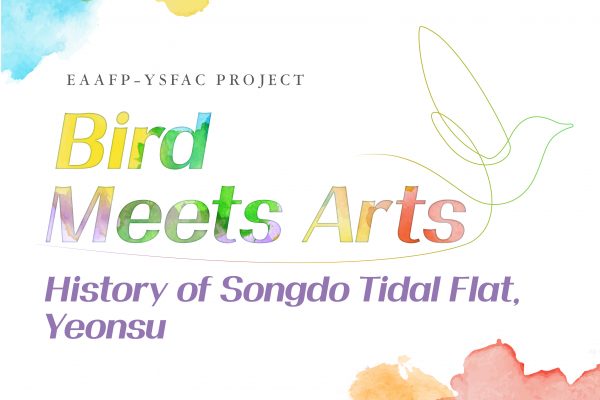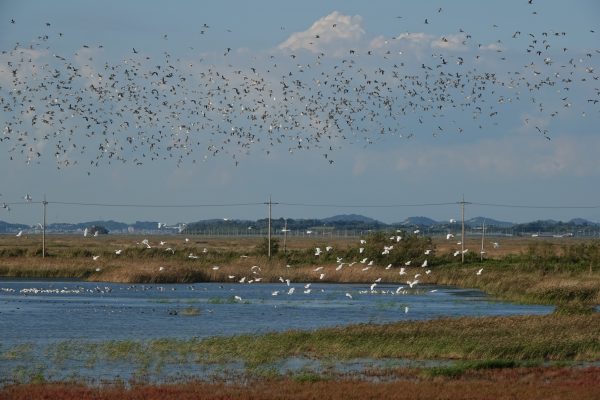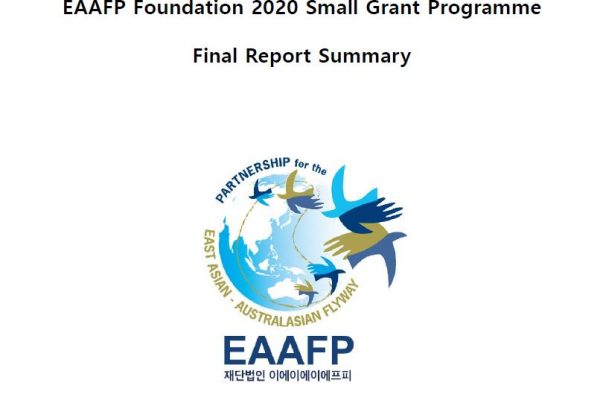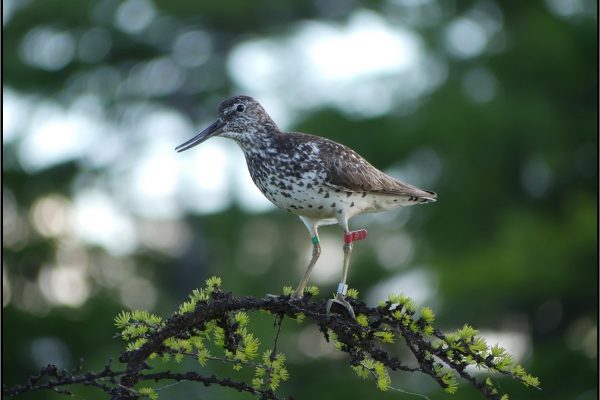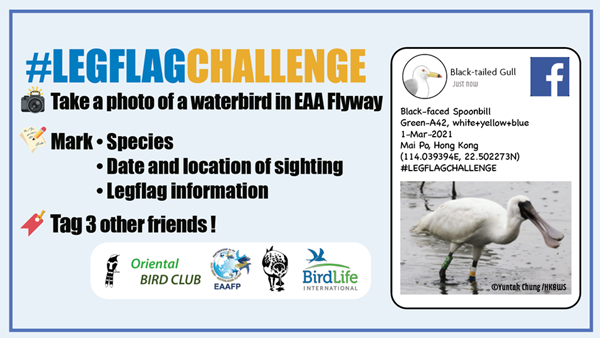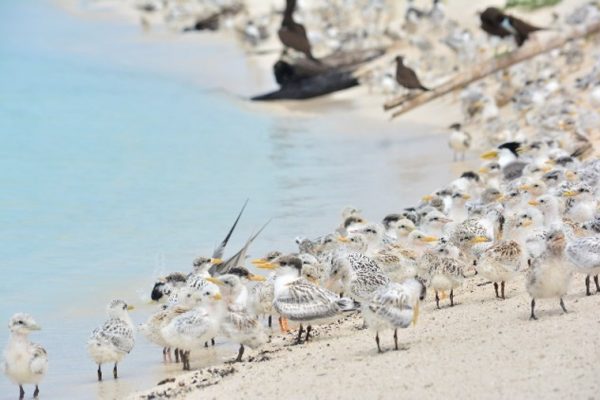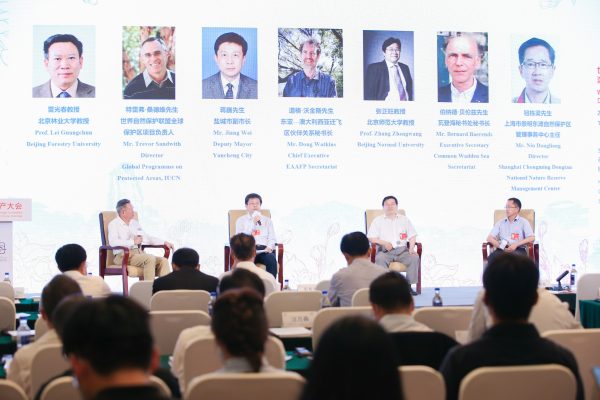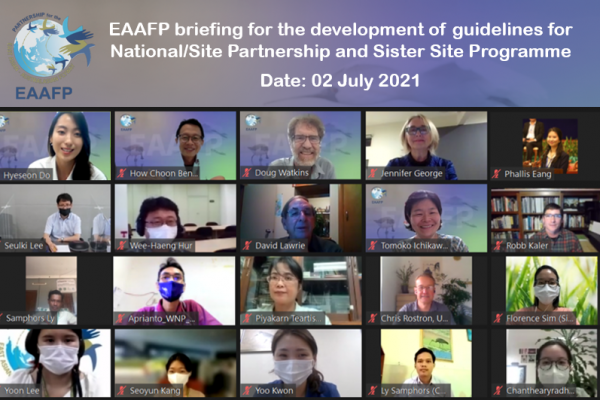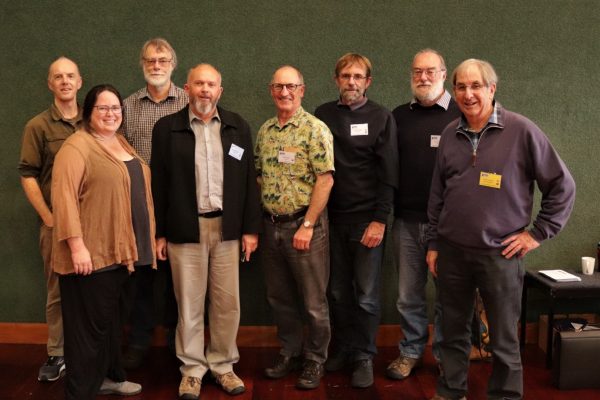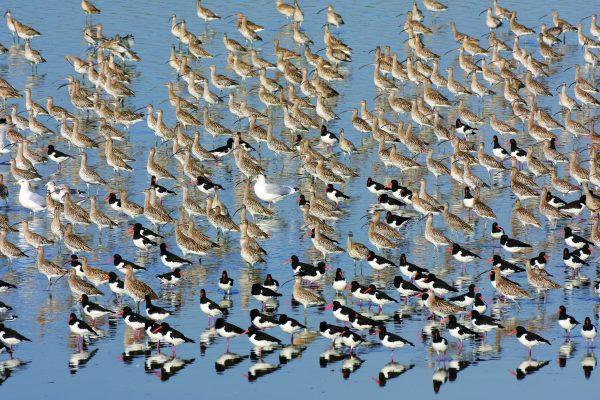-
EAAFP Foundation released “Bird-Meets-Arts” Ep.3 History of Songdo Tidal Flat, Yeonsu
The EAAFP Foundation and Yeonsu Foundation of Arts and Culture (YSFAC) released the third episode…
Continue reading -
The training workshop for wardens/rangers to conserve Hwaseong wetlands (10 days in August & November, in the RO Korea)
Birds Korea will hold a workshop to train the future local wardens to conserve the Hwaseong wetland for five days from 9th to 13th August with the support of…
Continue reading -
EAAFP Foundation’s 2020 Small Grant Programme Final Report has been Finalized
On 28th July 2021, the final report…
Continue reading -
Advancing research on Nordmann’s Greenshanks and Common Redshanks in Schaste Bay
Article prepared by Vladimir Pronkevich1, Konstantin Maslovsky2, and Philipp Maleko3,4 During the summer of 2021, we continued studying the breeding ecology of Endangered Nordmann’s Greenshank (Tringa guttifer) and…
Continue reading -
Join the #legflagchallenge and contribute to migratory bird conservation!
This year, the EAAFP Secretariat is teaming up with the Oriental Bird Club, BirdLife International and the Spoon-billed Sandpiper Task Force, to launch…
Continue reading -
EAAFP Small Grant Fund project: 2021 Tubbataha Seabird Survey, Philippines
Seabirds spend their entire life in the open ocean, hence, they are a good indicator of coral reef health. Their nutrient-rich droppings fertilize roosting grounds and the surrounding water to the benefit of other marine life. Seabirds are one of the most highly threatened species of animals. Although they have a relatively long life span, they breed much slower and have fewer offspring than other birds in general. Partly supported by EAAFP Small Grant Fund for Working Groups and Task Forces, this year, the Tubbataha Management Office (TMO) use seabirds as an indicator to assess of how well – or how badly – the site are conserving Tubbataha Reefs Natural Park, A Flyway Network Site (EAAF 123) in the Philippines. We monitored the population of the seven species that breed in the Park, the: Red-footed Booby (Sula sula), Brown Booby (Sula leucogaster), Masked Booby (Sula dactylatra), Great Crested Tern (Thalasseus bergii), Sooty Tern (Onychoprion fuscata), Brown Noddy (Anous stolidus), and endemic Black Noddy subspecies (Anous minutus worcesteri). We use various monitoring methods and integrate results for a more accurate estimate of the populations. Distance counts are conducted once a month, while direct counts are done once a quarter. In-flight counts are done late in the afternoon, and dawn counts are made before the birds leave the islet to forage for food. When called for, we would do night counts of birds that come to roost after sundown. Adults, subadults, juveniles, pullus, eggs, and nests of each species are counted. Two teams conduct the count of the various species in various life stages. In all, it took a total of 39 teams to complete the survey. In May each year, we join the marine park rangers (MPR) for quarterly monitoring. The Covid 19 situation interposed several complications that delayed our trip, with interesting results. Together with WWF-Philippines staff, and volunteers, we were finally able to set sail on 2 June 2021. This year’s survey was funded by the East Asian-Australasian Flyway Partnership (EAAFP), Department of Environment and Natural Resources (DENR), and Pilipinas Shell Foundation, Inc. (PSFI). Report of the surveys will be shared by the end of 2021. Tubbataha Reefs Natural Park is both a Ramsar site and a Flyway Network Site of the EAAFP. Located 92 nautical miles southeast of Palawan, it is a 97,030-hectare marine protected area which was established on 11 August 1988. It is the largest no-take marine protected area in the Philippines. Its two islets are among the last known safe breeding habitats of seabirds in Southeast Asia. Article prepared by Tubbataha Management Office. The Tubbataha Reefs Natural Park is in the middle of the Sulu Sea. It is composed of two atolls and a reef. The Bird Islet is in the North Atoll and the smaller South Islet is located in the South Atoll. Marine park rangers construct the ‘Tubbataha Hilton’, our shelter from the sweltering heat in Bird Islet. Photo © Segundo Conales Jr Our team from Puerto Princesa City met with MPRs at the ranger station upon arrival. Research Officer Retch Alaba gave a briefing on the work at hand and assigned tasks for each person. Photo © Rowell Alarcon Our first task before setting foot on the islets was to do a distance count. Park Ranger Jeffrey David (in blue) leads the count in Bird Islet, where 80% of the total seabird population of Tubbataha reside. Photo © Rowell Alarcon In the following days, the teams got busy with their respective tasks. Here, one group counts the eggs of the Great Crested Tern. Photo © Kymry Delijero Showing off their EAAFP hats, Angelique Songco and Rowell Alarcon count Brown Noddies. Photo © Kymry Delijero Marine Park Ranger Segundo Conales Jr., (with umbrella) counts the eggs, nests, and adults of Black Noddy in the structure while John Eric Magbanua, Bantay Dagat of Local Government of Cagayancillo (LGU), serves as recorder. Photo © Retch Alaba From left: MPR Noel Bundal, SN2 Paul Balonsay PN, and Joan Pecson, WWF-Philippines, start the in-flight count at 4:30, when birds begin to arrive from the day’s foraging. Photo © Kymry Delijero The team doing a night count of the Sooty Tern population that landed after sundown. The estimate was 6000 individuals! Photo © Kymry Delijero From left to right: Marine Park Rangers Segundo Conales Jr, SNDP Paul Balonsay PN, SN2 Francis Lim and Noel Bundal (in blue shirt) with tallies their day’s count in the native dining table inside our hut. Photo © Kymry Delijero We observed lesser seabirds, probably because we arrived at the end of the breeding season when most of the adults have left. We also counted lesser eggs because most of the birds were already in the pullus or juvenile stages. Photo © Kymry Delijero Black Noddies continue to occupy the artificial nesting structures we built in 2017. Last year, we added new structures made of PVC and steel pipes (above), which are designed to last longer. Photo © Gerlie Gedoria We planted saplings of native trees in the islet in 2020 but most did not survive. Marine Park Rangers Amado Cayabo (LGU) and Cris Caranay (TMO) construct bamboo guards around a sapling so birds would not build their nests on the saplings and use their leaves as nesting materials. Photo © Kymry Delijero The only known breeding Masked Booby in Philippines lain an egg for the fourth time (!) since 2019. A second egg appeared a week later. Photo © Retch Alaba We used the WWF-Philippines research vessel, M/Y Navorca for the survey. Here, the team disembarks for the survey in South Islet. Photo © Rowell Alarcon This year's seabird survey team. Photo © Rowell Alarcon
Continue reading -
“World Natural Heritage & Biodiversity: The Conservation and Sustainable Development of Coastal Migratory Bird Sanctuaries” side event at 44th session of the World Heritage Committee meeting, China
On the evening of 16th July, 2021, the extended 44th session of the World Heritage Committee meeting kicked off in Fuzhou, China. This is the first time in UNESCO’s history that World Heritage topics will be reviewed and discussed online. The meeting was held from 16th July to 31st July, 2021 evaluated 45 agenda items for the World Heritage List, including the inscription of the “Getbol, Korean Tidal Flats” of the Republic of Korea. Chinese President Xi Jinping sent a congratulatory letter to the session. A side event “World Natural Heritage & Biodiversity: Conservation and Sustainable Development of Coastal Migratory Bird Sanctuaries” was held on 17th July, hosted by National Forestry and Grassland Administration of China, and was organized by Yancheng Municipal People's Government, Eco Foundation Global, Fujian Provincial Administration of Forestry, and Fuzhou Municipal Administration of Forestry. Over 100 participants joined the side event. The side event aimed to: Showcase achievements on the conservation and sustainable development of coastal habitats for migratory waterbirds, highlighting the unique role of World Natural Heritage for biodiversity conservation. Voice out for conservation of coastal wetlands – to raise global attention, to seek for more international cooperation on ecological environment, promoting the concept of a community of life for man and nature. With the focus on how World Natural Heritage promotes global biodiversity conservation, the event invited acknowledgeable speakers from International Union for Conservation of Nature (IUCN), the Common Wadden Sea Secretariat, EAAFP Secretariat, Yellow Sea Migratory Bird Habitats (Phase I) World Heritage Site, Shanghai Chongming Dongtan National Nature Reserve, and to share experiences on conservation of coastal habitats and migratory waterbirds, as well as to share vision on international cooperation and collaboration. Prof. Lei Guangchun, Advisor of EAAFP Science Unit chaired a session of the event ©EAAFP Science Unit The event was kick-started with was moderation by Mr. Wang Zhigao, Director of Conservation Area Management Department, National Forestry and Grassland Administration (NFGA). Opening remarks were given by Prof. Shahbaz Khan, Director of the UNESCO Cluster Office in Beijing and Mr. Zhang Xinsheng, President and Chairman of the IUCN, as well as Mr. Peng Youdong, Deputy Director of NFGA. In the second session, the Summit Dialogue, the Advisor of EAAFP Science Unit, Prof. Lei Guangchun, was the moderator. Dr. Trevor Sandwith, Director of IUCN’s Global Programme on Protected Areas delivered a presentation to introduce the IUCN Global Protected Areas Programme and the Green List programme. Mr. Bernard Baerends, Executive Secretary of Common Wadden Sea Secretariat, shared the experiences of how the trilateral World heritage Site work and brought to conservation and contribute to the local communities. Mr. Doug Watkins, Chief Executive of the East Asian-Australasian Flyway Partnership Secretariat, spoke about the importance of joint effort for conserving wetlands in the EAA Flyway, and how the WH inscription foster the conservation, especially in the Yellow Sea region. Mr. Doug Watkins, Chief Executive of EAAFP Secretariat, delivering speech during the event ©Eco Foundation Global The last session was a Panel Discussion, with Mr. Jiang Wei, Deputy Mayer of Yancheng City, Prof. Zhang Zhengwang, Beijing Normal University, and Mr. Niu Dongliang, Director of Chongming Dongtan Nature Reserve Management Center. The tidal flats of the Yellow Sea are of global importance, especially for the congregation of many species of migratory birds that use the East Asian–Australasian Flyway. Migratory Bird Sanctuaries along the Coast of Yellow Sea-Bohai Gulf of China (Phase II) is now under intensive preparation to be included into the World Heritage List session of the World Heritage Committee. Panel discussion ©EAAFP Science Unit
Continue reading -
1st EAAFP briefing for the development of guidelines for National/Site Partnership and Sister Site Programme
1st Webinar Group Photo ©EAAFP Secretariat Starting with the speech of Mr. Robert Kaler, the Chair of EAAFP, the first webinar for Briefing on Development of Guideline/Recommendation for Site and National Partnership and Sister Site Programme was held on 2 July, 2021. Following the Decision 8 and Decision 9 at EAAFP MOP10, the Secretariat has been working with Ms. Jennifer George, project consultant to develop the guidelines strategically and efficiently. It will improve the 1,060 EAAFP FNS relationship among and beyond the network. The following Partners of EAAFP participated in the webinar: 5 Government Partners: Japan, Singapore, RO Korea, United States, Thailand 2 NGOs: New Zealand Miranda Trust and WWT 2 IGOs: ACB and Birdlife (Cambodia) 2 Site Managers from Indonesia Ms. George shared the background and expected outcomes through the guideline development. She highlighted that the FNS flows from relationships, hence securing and strengthening relationships within and between countries is the main purpose of this project. As 1,060 sites are crucial to migratory waterbirds, EAA Flyway holds 149 of those sites which some are twinned as Sister Sites. Ms. George shared the key terms of the guideline: Site Partnership (SP) National Partnership (NP) Sister Site Programs (SSP) Two case studies were presented to share the National Partnership in Japan, and strong Sister Site programs in Singapore. Ms. Tomoko Ichikawa (Presentation file), Ministry of Environment of Japan shared the 3 national networks (Anatidae, Shorebird, Crane), the structure of the NP, and the ongoing meetings in Japan. First, to strengthen cooperation among the Sites, she mentioned that each FNS in Japan belongs to 1 or more of the national networks. Second, she introduced the structure of the NP, where MOE-J carries out activities of the network in coordination with associated organizations. As well as coordinators of each species group network plays a key role publishing newsletters, forming mailing lists, creating Facebook page etc. to exchange information across the national FNS. She highlighted the many meetings well facilitated in Japan, such as the shorebird virtual meeting, the national CEPA WG meeting, the national liaison meeting, and workshops for FNS managers. The effort to share necessary information, encourage and support issues and discussions, and strengthen a cooperative relationship among site managers, local government and NGO all contributes to the excellent NP structure in Japan. Following are some key elements Ms. Ichikawa suggested for a NP: Network species group works well in mobilizing people for active participation and enthusiasm Coordinating cooperative activities Involvement of NGO to secure continuation on past achievements and the implementation of conservation works in the FNS Obtain the understanding of stakeholders by publishing CEPA materials Ms. Ichikawa further proposed some elements for the guideline: Changing the wording from ‘guideline’ to ‘guidance’ or ‘non-binding guideline’ Avoid too detailed and restrictive guideline as establishing a NP depends on the social condition and national stakeholders Highlighting the benefits of a NP The next case study was Mr. How Choon Beng (Presentation link) from National Parks Board, Singapore shared the Sister Site Programs. Sungei Buloh Wetland Reserve at the center of EAAF requires strong justification to secure the space for birds. Mr. How shared Singapore’s approach of regarding the entire population as the stakeholders. Hence, a shared understanding for the stakeholders to view the site as a national heritage, and a habitat for migratory waterbirds is essential. In support of this, Singapore encourages many programs to connect the people, and to enhance the 4 major MOU with China, Hong Kong, Malaysia and RO Korea. The MOU activities diversifies from school exchange, cross promoting other international sites as a tourist spot etc. As well as the MOU expands from sites to various institutions such as National Institute of Ecology, which Singapore held the 1st EAAF Shorebird Science meeting. Mr. How shared the key benefits of exchanging relationship opportunities, such as increasing research opportunities and sharing capacity building. Hence, the following suggestions were made for the SS Program: Strengthening research and management for capacity building Building target groups Utilizing technology to overcome travel and funding barriers Enhancing promotion and publicity Then the panel and open discussion was facilitated by Mr. Doug Watkins, the Chief Executive of EAAFP Secretariat. Mr. Watkins focused the discussion on three points: Defining the term “National Partnership” How to build relationships with other FNS on the Flyway How to develop more Sister Sites A question was raised by Dr. Piyakarn Teartisup, Thailand government partner of EAAFP, with recommendations regarding twinning sites nationally or internationally. Mr. Watkins encouraged to identify common points for linkage such as shared common species. Ms. Ichikawa supported the idea of common species, as Japan’s NP implementation worked best through species group based. Nonetheless, she highlighted the challenge of language barrier, hence initiated the support needed both locally and internationally. Mr. How also shared that a lot of the decisions in linking a Site comes from informal meetings. Such as, during MOP when small group discussions open it gives an opportunity to hear specific issues, challenges, or preferences on other sites. Mr. Terry Townshend, an advisor to the Beijing government on biodiversity, suggested in support of public engagement “to link sites using tracking studies, where individual birds are named by local schools and tracked between sites.” Finally, Mr. Fnu Aprinto, site manager from Wasur National Park Indonesia, shared despite its desire in building a relationship with other FNS there is a limit in the capacity of initiating this as all decision making is done by the Ministry of Environment and Forestry, the central government. Mr. Watkins concluded the open and panel discussion that the EAAFP Secretariat encourages the flexibility of the guideline and supports building strong relationship among sites by capturing he human elements on the shared biodiversity. Hence, in moving forward to articulate an effective and strategic guideline, he welcomed Partner’s suggestions in more depth through interviews that would be arranged by the Secretariat. EAAFP Partners can reach out to us through the contact information here: Ms. Jennifer George, Project consultant: jennifer@snapdragon.co.nz EAAFP Secretariat: secretariat@eaaflyway.net 1st Webinar video recording: Proposed Timeline:
Continue reading -
“Getbol, Korean Tidal Flats” inscribed on UNESCO World Heritage List
On 26th July, 2021, the 44th Session of the World Heritage Committee endorsed the inscription of the Republic of Korea’s tidal flats on the UNESCO World Natural Heritage List, marking an enormous step forward to secure the critical habitats of the Yellow Sea for millions of migratory waterbirds that depend on this area as a vital stopover on their migratory journeys from as far away as Australia and New Zealand to breeding grounds in Arctic Russia and Alaska. Great Knot and Bar-tailed Godwit ©WH Promotion Team of Korean Tidal Flat The inscription of the “Getbol”, the Korean name for tidal flats, was announced during the World Heritage Committee meeting held in Fuzhou City, China and follows over 10 years of intensive preparation by the Korean authorities. The four sites included in the Phase I inscription of Seocheon Getbol, Gochang Getbol, Shinan Getbol and Boseong-Suncheon Getbol, collectively cover over 128,000 hectares of coastal wetlands in the Southwestern part of the country. Additional areas will be added as part of a Phase II nomination. The shallow waters in the Yellow Sea region jointly shared by China, DPR Korea and Ro Korea hold some of the largest and most spectacular intertidal wetlands in the world. These sites support exceptionally rich biodiversity, but are best known for some of the largest congregations of migratory waterbirds in eastern Asia, many of which are globally threatened by habitat loss along their migratory pathways, collectively known as the East Asian – Australasian Flyway. Up to 100,000 shorebirds use the mudflats around Yubu island in the Seocheon Getbol during migration, including the Critically Endangered Spoon-billed Sandpiper and the Endangered Far Eastern Curlew. Other species, such as Vulnerable Saunders’s Gull and Endangered Black-faced Spoonbill stay to nest in the coastal wetlands of the Yellow Sea. “The inscription of the Getbol in the World Heritage List will mark a great shift of paradigm for Getbol tidal flats protection and management policy, as well as the increasing public awareness. The Getbol's World Heritage inscription means that the tidal flats managed by locals become a shared global property for the next generation of all humanity. All stakeholders involved with the Getbol will make the best effort to complete its Phase II extension and even further in the future.’’ said Dr. Kyong-O Moon, the Secretary-General of the Korea Getbol World Heritage Promotion Team. “The Korean Getbol inscription complements the “The Migratory Bird Sanctuaries along the Coast of the Yellow Sea-Bohai Gulf of China (Phase I)” World Heritage Site listed in 2019. It will strengthen international collaboration, particularly in the vision of transboundary joint efforts with China and DPR Korea, to conserve the wetlands of the Yellow Sea region, the irreplaceable migration hub for migratory waterbirds shared by the 22 countries in the Flyway,” said Mr. Doug Watkins, Chief Executive of EAAFP, an international partnership to conserve migratory waterbirds along the Flyway. “The UNESCO World Heritage Convention offers an exceptionally powerful framework to secure the future of globally important biodiversity. The BirdLife International Partnership look forward to working closely with the EAAFP and IUCN to secure the same status for the remaining such areas of the Yellow Sea, and to support the authorities to ensure all receive the best possible management for birds and people.’’ said Dr. Ding Li Yong, BirdLife International (Asia Division) Flyways Coordinator. Decision paper (download at: https://whc.unesco.org/en/sessions/44COM/documents/#amendment ) Far Eastern Curlew and others © WH Promotion Team of Korean Tidal Flat Black-faced Spoonbill © WH Promotion Team of Korean Tidal Flat Spoon-billed Sandpiper ©WH Promotion Team of Korean Tidal Flat Hooded Cranes in Suncheon Bay ©WH Promotion Team of Korean Tidal Flat Click [here] for the UNESCO WHC official announcement. Click [here] for the local news media archive. Local news reports: Korean Version: 한국의 갯벌’, 유네스코 세계유산 등재 2021년 7월 26일 ‘한국의 갯벌’은 제 44차 세계유산위원회(WHC)에서 유네스코 세계자연유산으로 등재 됐다. 이 지역은 뉴질랜드· 호주부터 러시아 알래스카까지 이동하는 수백만 마리 철새의 황해 상 중간기착지로서 세계적으로 중요하고 의미있는 서식지 보전에 매우 큰 발걸음이 되었다. 중국 푸저우에서 열린 제44차 세계유산위원회는 한국의 갯벌을 세계자연유산 등재로 최종 확정했다. 이는 한국이 10년 간 준비한 작업의 성과라고 볼 수 있다. 1단계 세계자연유산 대상지로는 서천갯벌, 고창갯벌, 신안갯벌, 보성-순천갯벌, 4곳으로 총 12만8000ha가 넘는 서남해해안 습지이다. 2단계 추진과정에서 추가지역들이 포함될 예정이다. 중국과 남북한이 공유하고 있는 황해지역은 세계에서 가장 크고 장관을 이루는 조간대 습지다. 이 지역은 생물다양성이 매우 풍부하고, 최대 규모 집단인 동아시아 지역의 이동성 물새 서식지 감소로 인해 전 세계적으로 가장 위협을 받는 지역이며, 동아시아-대양주 철새이동경로 상에 있다. 멸종위기에 처한 넓적부리도요, 알락꼬리마도요를 포함 한 최대 10만 마리까지 이동 기간동안 유부도 주변(서천 갯벌)을 이용한다. 또한 취약종인 검은머리갈매기와 멸종위기종 저어새와 같은 다른 종은 황해 연안 습지에 둥지를 튼다. 한국 갯벌 세계유산 등재추진단 문경오 사무국장은 “한국의 갯벌 유네스코 세계유산 등재는 갯벌 보호 및 관리 정책의 패러다임을 전환하는 계기가 될 것 이며, 대중 인식 증진에도 큰 기여를 할 것이다.” 이어서 “한국의 갯벌 유네스코 세계유산 등재는 지역 주민이 관리하는 갯벌에서 더 나아가 전 지구적으로 공유하는 자산으로 모든 인류를 포함하여 다음 세대에 넘겨줄 자산이 된다는 의미다. 갯벌과 관련된 모든 이해관계자들은 2단계(Phase II) 상향과 향후 더 확장할 수 있도록 최선을 다할 것이다” 라고 말했다. 국제철새보호 기구 동아시아-대양주 철새이동경로 파트너십(EAAFP) 사무국 더그 와킨스(Doug Watkins) 대표는 “한국 갯벌 등재는 2019년 세계유산에 등재된 ‘중국 황하이 연안-보하이 만의 철새 보호구역(1단계)’을 보완한다. 특히 국경을 넘어 공동 비전인 황해 보전을 위해 중국과 남북한의 국제 협력과 황해 지역의 습지를 보전하여 대처할 수 없는 22개국이 함께 공유하는 철새이동경로 보전 노력이 강화 될 것” 이라고 말했다. 딩리 용(Ding Li Yong) 버드라이프 인터내셔널(BirdLife International) 아시아 지부 이동경로 코디네이터는 “유네스코 세계유산협약은 세계적으로 중요한 생물다양성의 미래를 보장하기 위한 매우 강력한 프레임워크를 제공한다. 버드라이프는 EAAFP및 유네스코 심사 자문기구인 세계자연보전연맹(IUCN) 과 긴밀히 협력하여 황해의 나머지 지역에도 동일하게 보전을 확보하여 당국이 조류와 인류을 위한 최상의 관리를 받을 수 있도록 지원하기를 기대한다” 라고 말했다.
Continue reading

